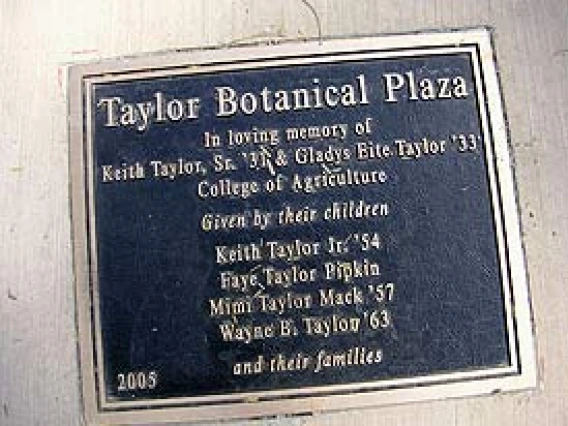Let us explain...

As a campus, we aim to use the landscape to preserve and promote respect for heritage and also to inspire and educate. We believe that as a land-grant institution, it is our duty to convey science-based practices and that we can do this through innovative approaches applied in planning, designing, constructing and maintaining the campus grounds.
Ultimately, we aim to transform and improve the landscape to better support the UA Mission to “discover, educate, serve and inspire”. One way we achieve this is through the development of special educational garden spaces where important concepts are conveyed or "interpreted". These interpretive gardens are passively enriching the visitor experience or are being actively used for arboretum tree tours or for formal instruction in a wide variety of university courses beyond plant science!
Bronze Interpretive Signage
In 2024, new interpretive signs were installed at a number of important landscape sites across campus to identify the location for its importance in the arboretum. Click here to view the map and photos of the new signs.
Campus Learning Gardens

The Victoria Maizes Wellness Walk
The Victoria Maizes Wellness Walk was developed through collaboration between The Center for Integrative Medicine and the University of Arizona Campus Arboretum to honor Dr. Victoria Maizes, MD for her contributions to Integrative Medicine and her passion for embracing nature as a source of rejuvenation. The wellness walk offers a guided experience through desert adapted plants, accompanied by prompts that invite reflection, presence, and connection to the natural world on campus. Learn More About the Wellness Walk.

The Coral Reef Garden
Toward the goal of enhancing the value of the campus grounds, the Campus Arboretum worked with nurseries and regional plant experts to design a garden using climate appropriate cacti and succulent plants that resemble a living coral reef. These inspiring oddities now adorn the planters surrounding the USS Arizona Memorial on the UA Mall drawing attention to this significant campus feature all while reducing use of water and labor in the landscape.

The Joseph Wood Krutch Garden
When the University of Arizona was established, Dr. James Toumey, a botanist for the Agricultural Experiment Station, started a cactus display garden that, eventually became what we now know as the Joseph Wood Krutch (pronounced KROOCH) Garden. The Joseph Wood Krutch cactus garden still stands as a symbol of the University’s responsibility as a Land Grant Institute to encourage land stewardship by encouraging education and research which sustains our appreciation of and connection to connection our history, and responsibility to our diverse home in the Sonoran Desert.

The Presidents' Pond
On the corner of Park Avenue and 2nd Street, hidden in plain sight is the “President’s Pond” - where a water feature from the original University President’s Queen Anne style campus home has been preserved. The pond has historically been planted with palms and other lush-looking species to give the impression of an oasis. Turtles and blue herons have frequented the pond as have many students, faculty, staff, and community neighbors seeking a quiet spot for rejuvenation. Over time, intensive use of the space has taken a toll. Thanks to the support of generous donors, this beloved campus and community gathering spot has a new lease - a bronze interpretive plaque was installed, the patio was expanded and improved, mulched planting beds with trees and shrubs were installed around the perimeter and irrigation reconfigured to reduce damage to the hardscapes. We are delighted with the fresh feel of the space and will offer bench sponsorships to enhance the use of this campus gem in the 2023-2024 year.

The Howard Gentry Agave Garden
In 2006, arboretum volunteers planted a garden under the shade of trees on the south side of the Physics and Atmospheric Sciences building. Over time, some specimens multiplied and thrived while others in the garden gradually completed their lifespan. In 2024, we invited other volunteers to assist in collecting and planting replacements. We also installed a bronze interpretive sign that will stand the test of time and anchor the location in the long term as a tribute to the World's leading Agave expert Howard Scott Gentry. To learn more about the Agave Garden, click here.

The Fragrance Garden
Recent research* has identified more than 100 oils released from desert plants. These oils are released into the air when it rains, producing a complex and soothing fragrance desert dwellers love. As it turns out, many of the oils produced by desert plants are similar to those known by forest bathers to reduce stress and create a relaxed state for humans. With the goals of supporting the well being of campus students, faculty, staff and visitors during stressful times, the Campus Arboretum installed a garden full of fragrant plants near the Campus Health Center on the UArizona main campus. To learn more about the project, visit: /student-projects/2023-fragrance-garden

The Resilience Garden
This garden was inspired by plant characteristics that contribute to their resilience with the hope that visitors will consider the relevance of these practices in the human realm.

Taylor Botanical Plaza
On January 31, 2005 Keith Taylor Sr and Gladys Eite Taylor would have been married 75 years. So on that date, the two College of Agriculture alumni were honored at a naming ceremony in Taylor Botanical Plaza, at the entrance to newly refurbished Herring Hall. The plaza embodies the Campus Arboretum commitment to integrate botanical education into the main campus landscape. It includes leaf impressions and bronze plaque embedded in the concrete representing significant plant taxonomic groups. For more information on the Taylor Family's tribute, visit: /taylor-botanical-plaza-dedication

The Mark Dimmitt Desert Plant Conservatory
Plants are fundamental to the function and health of all terrestrial ecosystems, however, humans have evolved to prioritize objects and phenomena that are atypical of plants, creating a sort of "plant blindness". Desert plants have evolved toughness to many abiotic stresses and unusual forms that make them an ideal tool to treat plant blindness. Their unusual forms catch our attention, and their complex adaptations and responses to their environment inspire greater appreciation for the critical interactions occurring therein. With this is mind, the desert plant conservatory was imagined as a place designated for the display of a diverse collection of the most unusual desert plants available to us.

